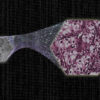Researchers at Linköping University, Sweden, have developed a digital display screen where the LEDs themselves react to touch, light, fingerprints and the user’s pulse, among other things. Their results, published in Nature Electronics, could be the start of a whole new generation of displays for phones, computers and tablets.
The LEDs are made of a crystalline material called perovskite. Its excellent ability of light absorption and emission is the key that enables the newly developed screen.
“We’ve now shown that our design principle works. Our results show that there is great potential for a new generation of digital displays where new advanced features can be created. From now on, it’s about improving the technology into a commercially viable product,” says Feng Gao, professor in optoelectronics at Linköping University (LiU).
Digital displays have become a cornerstone of almost all personal electronics. However, the most modern LCD and OLED screens on the market can only display information. To become a multi-function display that detects touch, fingerprints or changing lighting conditions, a variety of sensors are required that are layered on top of or around the display.
In addition to the screen reacting to touch, light, fingerprints and the user’s pulse, the device can also be charged through the screen thanks to the perovskites’ ability to also act as solar cells.
“Here’s an example—your smartwatch screen is off most of the time. During the off-time of the screen, instead of displaying information, it can harvest light to charge your watch, significantly extending how long you can go between charges,” says Chunxiong Bao, associate professor at Nanjing University, previously a postdoc researcher at LiU and the lead author of the paper.
For a screen to display all colors, there must be LEDs in three colors—red, green and blue—that glow with different intensity and thus produce thousands of different colors. The researchers have developed screens with perovskite LEDs in all three colors, paving the way for a screen that can display all colors within the visible light spectrum.
But there are still many challenges to be solved before the screen is in everyone’s pocket. Zhongcheng Yuan, researcher at the University of Oxford, previously postdoc at LiU and the other lead author of the paper, believes that many of the problems will be solved within ten years:
“For instance, the service life of perovskite LEDs needs to be improved. At present, the screen only works for a few hours before the material becomes unstable, and the LEDs go out,” he says.
More information:
A multifunctional display based on photo-responsive perovskite light-emitting diodes, Nature Electronics (2024). DOI: 10.1038/s41928-024-01151-x
Provided by
Linköping University
Citation:
Perovskite LEDs for next-generation digital displays can detect fingerprints, changing light conditions and more (2024, April 10)



